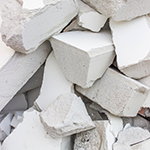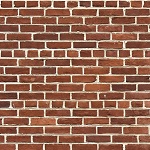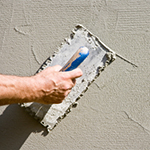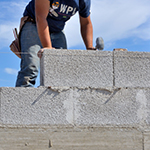Hit enter to search or ESC to closes
The construction and civil engineering industry are major users of lime products. Lime currently plays an important part in the following areas:
In the drying, improvement and stabilisation of soils to provide a platform for heavy construction (as explained below).
As a component of mortars, exterior rendering and interior plasters.
As an anti-stripping agent in the production of asphalt and tarmac for road construction.
As a binder in the productions of bricks, aircrete, fire resistant board and concrete.
Overall the use of lime provides numerous environmental benefits, as well as a superior aesthetic appeal to that of normal cheaper materials.


Although widely known as Soil Stabilisation, there are a number of distinct processes which can be carried out by the addition of quicklime to waterlogged, clay bearing or contaminated land. Improvement is the first process step, which is the drying out of water bearing material by the heat generating reaction with quicklime, this also converts some of the free water to hydrated lime. Using this process, it is possible to convert an unworkable site into a solid working platform providing a base for construction development, or alternatively as a potential area for agricultural use.

Hydrated lime can be used as an additive to hot mix asphalt used for road surfacing. The addition of lime increases the resistance of the asphalt to water stripping, allowing it to maintain strength and provide good resistance to heavy stress i.e. for road surfaces prone to regular traffic or congestion. Lime also acts as a mineral filler which increases the viscosity of the binder, increasing the stiffness, tensile strength, compressive strength and resistance to water stripping. Asphalt is currently used for the majority of road networks throughout the world. Infrastructure is often dependent on the quality of road surfaces, and without its superior materialistic properties, roads would be more hazardous and all types of vehicles would be prone to damages and accidents.

Quicklime is mixed with cement, sand, water and aluminium powder to give a slurry which rises and sets to form honeycomb structured blocks which have excellent thermal and sound insulation properties. The heat generated when quicklime reacts with water and the alkaline conditions combined with aluminium powder generates hydrogen bubbles which cause the blocks to rise. The heat generated subsequently causes the slurry to set. The blocks are then heated in an autoclave, which promotes reactions between calcium and silicates in the sand or PFA and gives extra strength. Dolomite lime and/or modified quicklime can be added to reduce excessive shrinkage or cracking, an issue which is increasingly useful for highly stressed materials, such as busy road junctions.

Current cement-lime mixes provide the most efficient mix in regards to possessing both good ‘soft’ properties as well as controlled strength. The benefits of using lime and lime-cement mortars can be divided into two categories; ‘soft’ and ‘hard’ characteristics. They are as follows:
Mortars containing lime absorb carbon dioxide from the atmosphere which dissolves within any water present in the mortar, and reacts with the lime to produce carbonate crystals. These crystals form in available spaces such as cracks and grow, thereby sealing the cracks. This ‘self-healing’ characteristic reduces water penetration and increases durability.
Mortar is essential in the construction industry, without it we would have nothing to hold the bricks together that form our houses, offices and other buildings.

Internal plastering is used to cover up differences in level and to provide a surface which is suitable for the final decorative finish. The use of lime with cement nowadays provides a quick, strong and easily applied process of coating durable plaster. Other benefits are described as follows:

Lime concrete or “limecrete” is made by mixing controlled amounts of sand, aggregate, binder and water. Portland Cement is normally used as the binder, although nowadays hydraulic lime or hydrated lime can also be used. This type of concrete is used all over the world, including almost every type of transport surface from roads, runways, bus and rail tracks to the construction of buildings and even large dams.

Limewash is a traditional method of painting walls with a colour base that allows the masonry to breathe, providing both protection and aesthetic appeal. Limewash is also widely used in agricultural buildings due to its germicidal qualities coupled with its extreme ease of application and low cost.

Buildings pre 1900 would not have been built with cement but with a lime mortar. Therefore in order to conserve these buildings it is essential to use similar materials when doing so. To introduce cement or cementitious mortar would cause decaying due to the difference in chemical composition of cement and inevitably result in irreversible damage. Hydraulic lime mortars, hydraulic lime plasters and renders and lime putty are therefore all used for the restoration of majority of Europe’s built heritage. The restoration of these buildings is often important for surrounding communities, providing them with lasting historical and cultural heritage, prolonging the buildings use as a tourist attraction, and often even increasing the aesthetic appeal of the local area.

Made entirely of natural sand, lime and water, the raw sand-lime brick compound matures in reactors before it is compressed under vapour pressure to form sand-lime bricks. During the process of pressure-hardening in autoclaves, the large proportion of available calcium oxide in lime ensures that optimum calcium silicate hydrate crystals are formed to give the brick its high mechanical strength, density and stability.